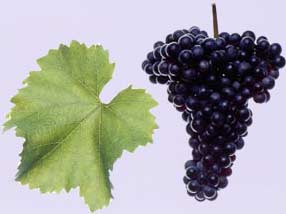Wines
of Austria- Grüner Veltliner
Louis Pasteur (noted French chemist and scientist) once said- “There is more philosophy in one bottle of wine then in all the books in the world.”
Austria's
Grüner Veltliner has suddenly become the hottest white
wine on everybody's
list. Until recently, wines made from Grüner Veltliner,
the most widely planted grape in Austria, enjoyed but faint
praise. New vintages were served by the pitcherful in Austria's
vinous equivalents to brew pubs called "Heuriger".
Abroad
grüners were known as pleasant quaffing wines best drunk
young. Today, though, suddenly, grüner veltliner - pronounced
approximately GROON-er FELT-lihnur and known in some circles
as GrüVe - is the wine of the hour from Sidney to San
Francisco. It inhabits vast sections of wine lists at bench
mark restaurants, is beloved by chefs, and gets idolized by
savvy sommeliers for its seemingly limit-less food friendliness
(it goes with everything from oysters to osso buco).
And
in London in 2002, Grüner Veltliner starred in sequence
of improbable blind tastings where its best exemplars outscored
stellar burgundies like Montrachet and Corton-charlemagne.
In truth, only older examples of Grüner Veltliner are
likely to be confused with Chardonnay;more commonly, the wine
suggest a cross between sauvignon blanc, for its fresh grassiness,
and viognier,for its character of stone-fruit pits. But the
grape also sops up intense minerality from shallow, rock-laced
soils and displays some of the petrol aroma otherwise associated
with riesling and pinot gris.
It
is perfume-driven wine, often redolent of freshly shelled
beans, bean sprouts, infused herbs and white pepper.Though
at least some Grüner Veltliner is grown in every Austrian
wine region, the most important plantings are in the country's
northeastern corner, near the Czech and Slovak borders.
The
best "Gruuner" vineyards, farmed for very low yields,
are in the Danube Valley - specifically in the terraced hills
of the Wachau and around the Kremstal (valley) and Kamptal
-north of Wachau and northwest of Vienna. The Wachau wines
are the beefiest of the bunch, while those from Kamptal and
Kremstal tend to be somewhat leaner.
The
wine can be as brightly structured as Sancerre, but generally
more viscous, owing to a distinctive juxtaposition of high
glycerin with substantial acid. Leaner examples of "Grüners"
are refreshing, while the more powerful ones finish long and
rich without seeming confected. Grüner Veltliners almost
never express wood; thus they provide welcome relief from
"chard - ennui"!
written
by John Winthrop Haeger for Saveur Magazine
CONTACT
HERZERL TOURS (sms@herzerltours.com)
IF YOU WANT TO KNOW ABOUT GRUENER VELTLINER FROM SPECIFIC
GROWERS, PRICES AND WHERE TO BUY IN THE USA.
Return to the top of page
Wines
of Austria- Zweigelt
At
its best, Zweigelt wine combines the bite and fruity character
of the Blaufränkisch grape and the body of St. Laurent
 |
Zweigelt
is a red wine grape variety developed in 1922, at
the Federal Institute for Viticulture and Pomology at Klosterneuburg,
Austria, by Fritz Zweigelt (who was later
to become the director of this institute). A crossing of Blaufränkisch
and St. Laurent varieties, it is now the most widely-grown
red grape variety in Austria, as well as having some presence
in Canada's vineyards.
Zweigelt is said to combine some of the best qualities of
its parents: winter hardiness (resistance to frost), late
bud-break, and early ripening. It does have a tendency to
over-crop, leading to low quality if not corrected.
At its best, it combines the bite and fruity character of
the Blaufränkisch grape and the body of St. Laurent.
When the crop load is high, however, the wine can be too dilute.
Because of its fruity characteristics, it has been compared
to the wines produced from the Gamay grape, like the red wines
of Beaujolais.
If the body of the wine is full, it can be age-worthy and
serious, although most Zweigelt is enjoyed young.
Return to the top of page
|

